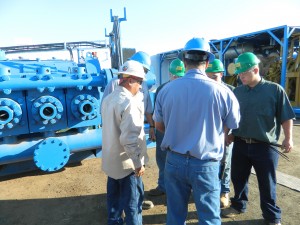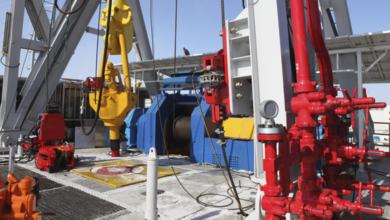HSE Corner: Communication, participation among simple steps to boost JSA effectiveness
By Joanne Liou, editorial coordinator
Redundancy can lead to complacency, and often, it takes a careless mistake and avoidable event to remind people to treat an everyday task with the utmost care and safety measures. While a crew might be able to successfully trip in/out of the hole more than a dozen times, it only takes a second or one lapse in judgment for an accident to happen. In one incident where a crew member fell from a different level, although the worker was able to miraculously walk away afterward, it was a stark reminder of the importance of discussing tasks to ensure everyone involved is on the same page.
“In the investigation afterward, the crew said, ‘We’ve done this 100 times. We didn’t quite discuss it.’ There was not a clear understanding, and one of the crew members did it a different way than they did it the previous time, and nobody caught it,” Mike Brown, COO of Keen Energy Services, explained.

In an environment where misplacing a tool or not communicating just one piece of information can lead to an injury or fatality, the job safety analysis (JSA) has the potential to prevent the worst-case scenario. Yet, even the JSA can fall victim to becoming an all-too-familiar practice that might not be altogether dismissed but instead, subconsciously ignored. Mr Brown and Anthony Zacniewski, HSE director at Bandera Drilling, share ways to maximize the effectiveness of a JSA, not by any extreme measure but by revisiting some of the basic building blocks: communication, participation and giving people the responsibility to speak up.
JSAs are one of the most common preventive measures executed multiple times on a daily basis, making it a valuable and effective safety tool if properly delivered, understood and used by each crew member. “It’s a discussion with employees or parties involved prior to doing a job or task,” Mr Brown said. “The JSA is to be a group or team conversation on completely understanding the job or task at hand, what the job is to accomplish, what each individual’s duty is within that job or task, the tools needed, to identify the hazards or potential hazards of that job or task and to discuss how to eliminate or mitigate the recognized hazards before the job or task starts.”
Part of the monotony of some repetitive tasks starts with an average JSA. “Your average JSA is one where the guys sit there and talk about what they’re going to do, and they’re nonchalant about it,” Mr Zacniewski said. “Some of the better JSAs are the ones where everybody participates, not just one person telling you what you’re going to do and what the hazard is.”
Participation involves contributing to the conversation and visually and mentally acknowledging the steps and associated hazards. “You can look at somebody while you’re discussing this, and you can tell if it’s the deer-in-the-headlight situation or if they really understand,” Mr Brown said. “If they’re not paying attention, you need to stop and make sure that everyone takes it seriously and is involved. Checking for understanding is a must.”
For both new and experienced crew members, talking the talk might come easy, but it is more important to understand the hazards that are identified and their role in mitigating the risks involved.
A problem, not just limited to JSAs, is the assumption that each crew member is in sync with what is happening. Whether there is a new crew member or if a message is not effectively communicated, each person should have the power to stop a job in the name of safety. “Everyone involved in the job has the authority and obligation to stop, if they see or feel that there’s an issue that doesn’t look right or feel right,” Mr Brown said. Putting things into perspective, Mr Brown explained that a JSA is much like a sports team’s huddle and strategy to run a play.
“How many teams run a play without a huddle? If somebody doesn’t understand, they call a time-out,” Mr Brown said. “If someone doesn’t understand what to do once they get out there, they stop the job and call a time-out, they step back and communicate and either continue with a clear understanding or go back to the drawing board and modify or start the JSA over again.”
Although it might be easier said than done, a crew member should feel comfortable enough to be able to say stop. “That’s one of the hardest things that we’re trying to push,” Mr Brown said. A JSA might be the preliminary step before undertaking a task, but it should not be confined to being performed only once. A JSA can be discussed multiple times through any given job or task. “If you don’t understand or feel safe, then don’t do it.”

While paperwork is involved and a template might be used for routine tasks, the delivery of the JSA makes the difference in effectiveness. “You cannot judge a JSA by the piece of paper you get,” Mr Zacniewski said. “It’s by the people you have in place that are talking about that JSA. It’s the actual participation. The JSA is only as good as the people who are putting it together.”
While template JSAs might be used for the more common tasks, such as scrubbing or making a connection, work conditions will vary from day to day and in different locations. One easily avoidable mistake Mr Zacniewski encounters is the failure to acknowledge those variable elements. “An existing JSA will not work in adverse conditions or if you have equipment failure,” he said. “You have to set the job down and go to a different JSA or revise the current JSA.”
“Nothing is fail-proof when you have people involved,” Mr Zacniewski said, but as a safety staple onshore and offshore alike, the purpose of a JSA is consistent – to create a safe work environment by presenting potential hazards and how to mitigate them in the first place. “I cannot tell you how many lives it has saved, but I can tell you if you’re not doing it, you’ll be able to count the lives you lost.”



